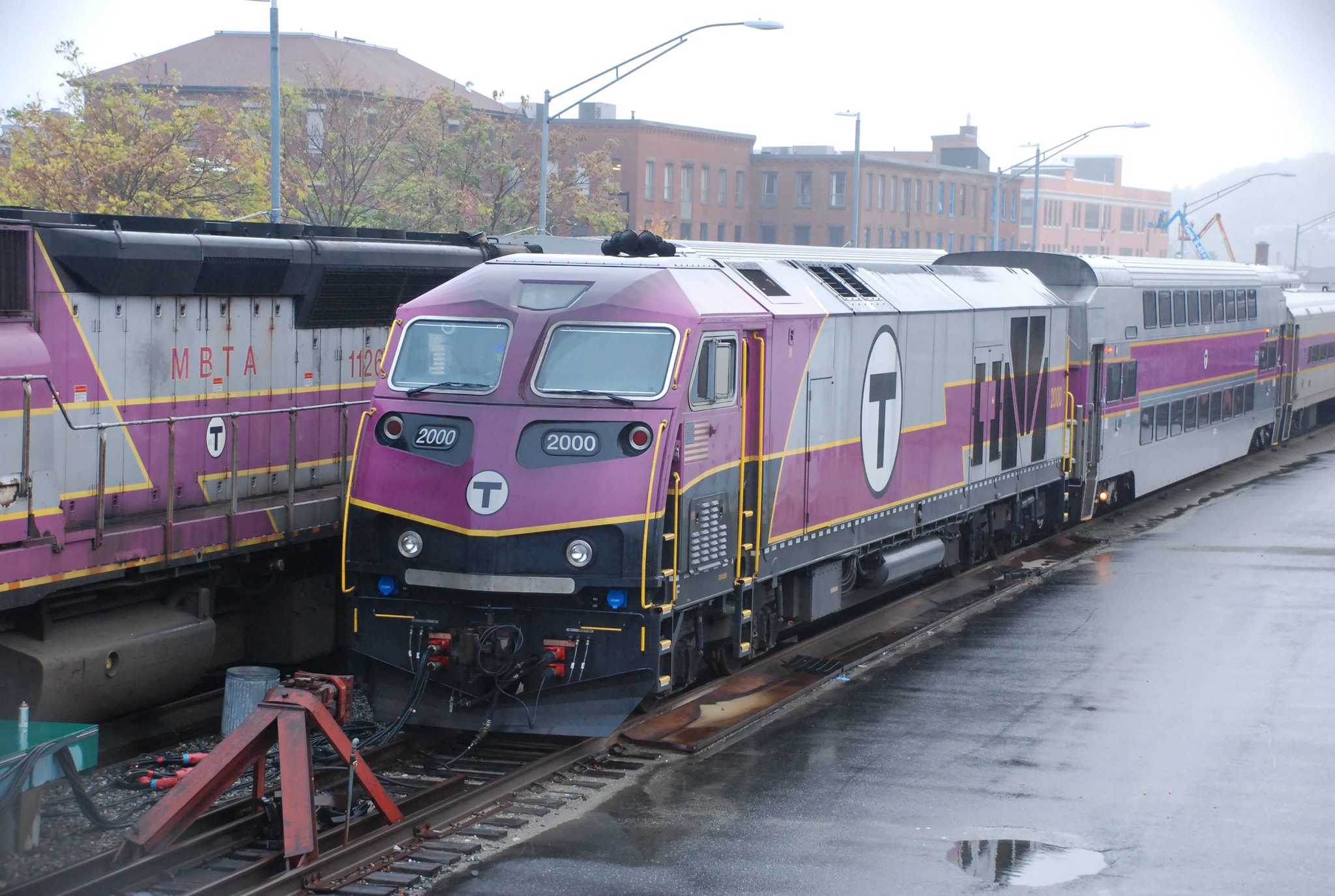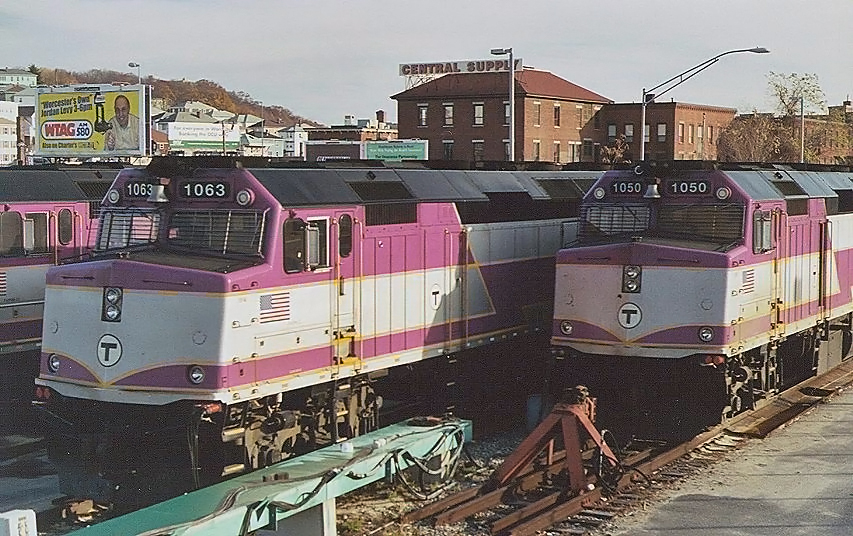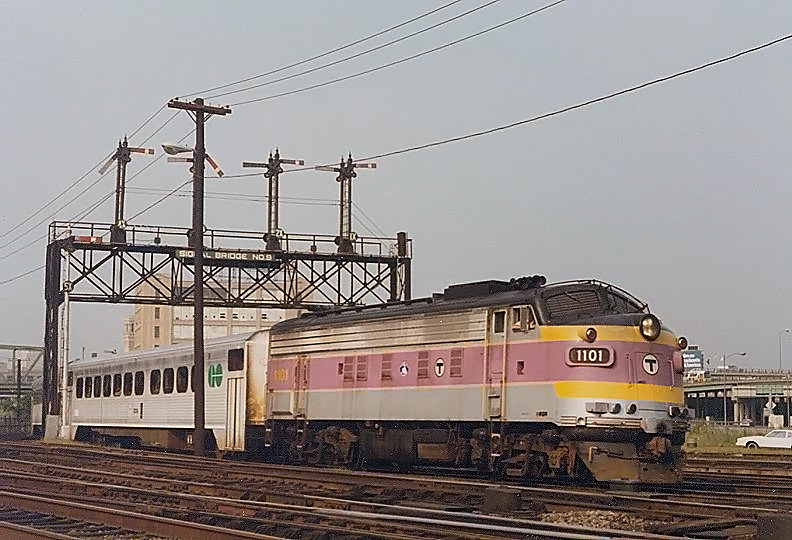MBTA Commuter Rail: A General Guide
Last revised: September 6, 2024
By: Adam Burns
Boston, a city with rich historical roots and modern flair, can be challenging to navigate. Happily, the Massachusetts Bay Transportation Authority (MBTA) provides an efficient solution with its comprehensive commuter rail service.
The system has been in operation since 1964 and is a vital component of the transportation needs within the greater Boston region.
Trains utilize 394 miles of total track and serve 135 stations. It is operated under contract by Keolis, which took over operations on July 1, 2014, from the Massachusetts Bay Commuter Railroad Company (MBCR).
This article offers a blend of historical context, current insights, and practical knowledge for anyone planning to use the MBTA's commuter rail.
 MBTA HSP-46 #2000 lays over at Worcester, Massachusetts on a rainy October 22, 2016. Doug Kroll photo.
MBTA HSP-46 #2000 lays over at Worcester, Massachusetts on a rainy October 22, 2016. Doug Kroll photo.Historical Background
Origins
The origins of the Massachusetts Bay Transportation Authority (MBTA) commuter rail service trace back to the early 19th century when the industrial revolution was rapidly transforming the United States.
The country's first successful passenger rail service began between Boston and Newton in 1834, a pivotal move by the Boston and Worcester Railroad (a later component of the Boston & Albany, a New York Central subsidiary), highlighting the region's early adoption of train travel.
Expansion and Early Milestones
Multiple railroad companies began to operate in the greater Boston area, spurring economic growth and urban development.
The early dominance of the Boston and Providence Rail Road, Boston and Maine Railroad, and the Old Colony Railroad established several lines that would much later be incorporated into the MBTA's commuter rail network.
The intricate spider web of railroads served not just commuters but freight and military needs during crucial periods, including the Civil War and both World Wars.
Advent of Public Control
By the mid-20th century, the decline of railroads due to the rise of the automobile era was evident. Railroads conglomerates were fragmenting and many were nearing bankruptcy.
At the time, the Greater Boston region was primarily served by the New York, New Haven & Hartford (which blanketed much of Massachusetts) and the Boston & Maine. In addition, the New York Central's Boston & Albany operated a through route heading west towards Albany, New York.
In response to this decline, Massachusetts was one of the first states to take steps in consolidating and preserving this valuable mode of transportation. The MBTA, established in August, 1964, gradually assumed control and integrated these disparate rail services into a cohesive network over the following decades.
Present-Day Operations
System Overview
Today, MBTA's commuter rail serves more than 122,000 passengers on weekdays, operating over 394 miles of track and encompassing 14 primary lines that radiate from Downtown Boston's two major hubs: North Station and South Station. These routes serve some outlying 50 communities.
Key Lines and Destinations
The MBTA commuter rail network extends far beyond Boston, reaching into various parts of Massachusetts and even touching neighboring states. Notable lines include:
- **Framingham/Worcester Line**: Connects Boston with Worcester, passing through key suburban areas like Newton and Framingham.
- **Lowell Line**: Travels from North Station through historic, mill-era Lowell, an early center of America's industrialization.
- **Haverhill Line**: Running through scenic Merrimack Valley, ending in Haverhill.
- **Providence/Stoughton Line**: Provides service from South Station to Providence, Rhode Island, making a crucial cross-state connection.
Rolling Stock and Technology
The MBTA fleet is divided into locomotive-hauled coaches and new self-propelled diesel multiple units (DMUs), focusing on efficiency and environmental sustainability.
Technological advancements, including Positive Train Control (PTC) implementationprovide enhanced safety and operational reliability.
Passenger information systems have also seen upgrades, with real-timetracking apps and modernized station displays to keep riders informed.
 MBTA F40PH-2Cs #1050 and #1063 are laying over at the terminal in Worcester, MA on November 11, 2006. Doug Kroll photo.
MBTA F40PH-2Cs #1050 and #1063 are laying over at the terminal in Worcester, MA on November 11, 2006. Doug Kroll photo.Traveler’s Guide
Planning Your Trip
**Route Planning**
Utilize the online MBTA trip planner or mobile applications such as Transit and Moovit to determine your optimal route and schedule.
**Ticketing and Fares**
Commuter rail tickets can be purchased in various ways:
- **Onboard (cash only with a higher fare)**
- **Ticket machines at key stations**
- **MBTA mTicket app**: This is the most convenient, allowing you to buy and display tickets through your smartphone.
Fares are zone-based, ranging from Zone 1A (inner-city Boston) to Zone 10 (furthest points). Discounts are available for seniors, people with disabilities, and children.
**Parking**
Many commuter rail stations offer parking facilities but be sure to check MBTA's website for specific details on fees and availability.
On the Train and at the Station
**Boarding Tips**
Arrive a few minutes early, especially during peak hours. Most stations will have clearly marked boarding areas, but when in doubt, check with station staff or use the MBTA app for track assignments.
**Riding Guide**
- **Seating**: Choose open seating in general cars, or utilize quiet cars if you prefer a tranquil environment.
- **Onboard Amenities**:
Wi-Fi, restrooms, and bike storage are available on selected services. Make sure to check specifics based on your route.
Accessibility
The MBTA is committed to providing accessible services for all passengers. Stations are equipped with ramps, elevators, and designated boarding assistance for the disabled. Always communicate special needs in advance for the smoothest journey.
Enhancements and Future Prospects
Recent Developments
MBTA has been actively focusing on improving infrastructure and services. Recent projects include:
- **South Coast Rail Expansion**: A significant project aimed to extend service to Fall River and New Bedford by spring 2025.
- **Fleet Upgrades**: New coaches and locomotives designed for better fuel efficiency and passenger comfort.
Planned Improvements
Future enhancements plan to focus on:
- **Electrification**: The agency is currently considering converting diesel lines to electric, reducing environmental impact.
- **Network Extensions and Frequency Increases**: Proposals for expanding service coverage and increasing train frequency, particularly during peak hours.
Tips for an Enjoyable Experience
Navigating the MBTA's commuter rail system can be effortless and enjoyable with a bit of planning. Here are some tips for both locals and tourists:
- **Peak vs. Off-Peak**: Travel during off-peak times if possible to avoid crowded trains and to enjoy a more relaxed journey.
- **Exploring Beyond Boston**: Utilize the commuter rail to discover other parts of Massachusetts and beyond. Historical towns like Salem, Lexington, and Concord are easily accessible.
- **Stay Informed**: Follow MBTA’s social media accounts and register for alerts to stay updated on service changes or disruptions.
Light Rail Service
Beyond commuter rail operations, MBTA also operates a 26.7 mile light rail line known as the Green Line.
The Green Line, is one of the most iconic and widely used. This guide provides an overview and essential details about navigating the Green Line.
The Green Line is the oldest subway line in the United States, with its first section opening in 1897. It serves as the spine of MBTA's light rail network, connecting downtown Boston with its western and northern suburbs.
The route is color-coded and divided into four branches: B, C, D, and E. Each branch originates from Park Street or Kenmore Station in downtown Boston and extends outward to various destinations.
- **Green Line B (Boston College):** Starts at Boston College and runs along Commonwealth Avenue, passing through Brighton and Allston neighborhoods before reaching Kenmore Station.
- **Green Line C (Cleveland Circle):** Begins at Cleveland Circle, travels along Beacon Street through Brookline, and proceeds to Kenmore Station.
- **Green Line D (Riverside):** Originates from Riverside Station in Newton, following a former commuter rail line, and provides a more suburban route into the city.
- **Green Line E (Heath Street):** Begins at Heath Street in the Mission Hill neighborhood, running along Huntington Avenue, serving major institutions like Northeastern University and several hospitals.
Tips for Using the Green Line
1. **Fares and Tickets:** MBTA's fare system includes both single-ride tickets and reloadable CharlieCards. A CharlieCard offers discounts compared to paper tickets. You can purchase these at vending machines in most major stations.
2. **Schedule and Frequency:** The Green Line operates from early morning until late at night, with varying frequencies depending on the time of day.
3. **Transfers:** The Green Line intersects with the Red, Orange, and Blue lines at Park Street, Downtown Crossing, and Government Center, making transfers relatively straightforward.
4. **Accessibility:** All Green Line trains and most stations are wheelchair accessible. Elevators and ramps are available, but it’s advisable to check the MBTA website for real-time updates on elevator outages or maintenance.
5. **Etiquette and Safety:** It's common courtesy to allow passengers to exit before boarding and to offer seats to those in need. Pay attention to announcements for any service changes or delays, especially during winter when weather can affect operations.
6. **Apps and Real-time Tracking:** Utilize the MBTA’s official app or websites like Transit and Moovit for real-time tracking, route planning, and service alerts, ensuring a smooth journey on the Green Line.
By understanding the branches and operational nuances, using the Green Line can be a convenient and efficient way to navigate Boston, whether you’re a daily commuter or a tourist exploring the city's attractions.
 MBTA's classic era; FP10 #1101 pulls an inbound train of leased GO Transit coaches under signal bridge #9 as the train enters Boston's South Station on August 3, 1981. Doug Kroll photo.
MBTA's classic era; FP10 #1101 pulls an inbound train of leased GO Transit coaches under signal bridge #9 as the train enters Boston's South Station on August 3, 1981. Doug Kroll photo.The MBTA commuter rail is more than just a transportation system; it's a historical artifact and a modern-day vital artery for Boston and its suburbs. Knowing its background, current operations, and future developments can enrich your travel experience.
Whether you're a daily commuter or a weekend traveler, the MBTA's services provide a bridge between history and modernity, ensuring that the rich cultural and economic tapestry of Massachusetts remains connected.
Embrace the journey, enjoy the ride, and discover all the treasures that lie within and beyond Boston, courtesy of the MBTA commuter rail.
